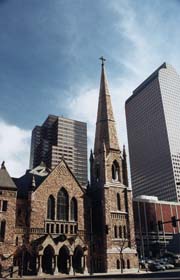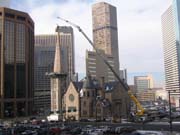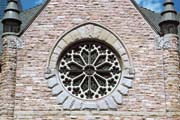

The Trinity United Methodist Church held its first services on Easter Sunday, April 1, 1888. By then, more than 3,200 tons of rhyolite and sandstone had been used to form the building, including the conical steeple.
The rhyolite fieldstone, which came from a quarry near Castle Rock, CO, withstood the elements admirably, despite its soft consistency. The sandstone - referenced only as “Kyune†in the original building drawings by Architect Robert S. Roeschlaub - was used for the trim, banding, window sills and general architectural detailing, because it was easy to carve and had the right color characteristics, according to Chris Haugen, the project manager from Castle Rock-based White Construction Group, the general contractor for the restoration.
But church records indicate that as early as 1910, just two decades after construction, signs of significant exterior deterioration of the sandstone trim were evident. In 1939, the Denver Building Department said the falling sandstone was a public nuisance and endangered the safety of passers-by, and they actually threatened to condemn the church. A total of $8,000 later (representing a large sum of money at the time), the problem still was not solved.
Over the next 80 years, church leaders debated what to do, and they embarked on a restoration effort in the 1960s that, not only failed to correct the problem, but actually accelerated the deterioration process.
“The Trinity United Methodist Church is 117 years old, and there have been a long litany of attempts to fix its deteriorating stone over the years,†said Jim Ranniger, the Trinity church trustee in charge of the restoration project. “But, in 1995, when the slate roof was replaced, we re-assessed the deterioration and realized we couldn't wait any longer.â€
During the Trinity roof restoration in 1995, Consulting Engineer Bill Barns, formerly of Colorado Springs-based The Florin Group (now merged with Bahr Vermeer Haecker Architects), literally climbed the roofer's scaffolding and photographed all the stone on the building. These images were used to obtain a grant from the Colorado State Historical Fund to comprehensively assess the stone's condition. “One of the main reasons for doing this was to develop a truly accurate estimate of what it would cost to restore the building,†said Barns, a specialist in historic restorations. “We then used this assessment to seek a grant for the stone restoration work.â€
The church was granted $688,000 over a three-year period, and agreed to match the funds. This still was not enough to complete the job, but it was more than enough to start. When these initial funds were exhausted, the congregation pulled together and contributed the remainder to finish the project in three years, instead of the anticipated 10 years.
The project was organized in 37 planes, or zones, to stage the work to match available funding, according to Barns. As part of this process, individual stones were photographed and the images were then sent to a stone fabrication shop to be drawn and numbered. Interesting notes about the stones - such as variations in depth - were included, along with specific descriptions from the original drawings from the 1880s. “It took roughly a year to do this, and we spent more than $100,000 on the drafting alone,†said Barns.
This meticulous process, along with other value engineering from White Construction Group and other project team members, allowed the project to be completed on time, roughly $3,800 under budget on a budget of $2,046,000, and with more work completed than originally specified.

The sandstone search
The next step was to find a replacement stone that both matched existing stone and provided more durability. Samples of the existing sandstone were distributed nationally to 20 stone suppliers. The team selected Pine's Stone Co. of Glenwood Springs, CO, as the contractor. The late Paul Pine and T.J. Sowieja, Pine's director of fabrication, ultimately found sandstone with the right color, graining, chemical composition, texture and density at a quarry owned by Delaware Quarries in Lumberville, PA - located near the site where George Washington made his famous Delaware River crossing in the early days of the U.S.“The composition of the new sandstone is much denser than the old sandstone,†said Haugen, who not only served as White Construction Group's project manager, but also has a degree in geology. “You could put a drop of water on the old sandstone, and it would immediately absorb it. With the new sandstone, the water just beads up on the surface, and that's exactly what we needed.â€
A total of 271 tons of new sandstone was installed for the Trinity restoration project.
Three approaches were used to replace deteriorated sandstone. First, the most badly deteriorated pieces were removed down to the “structural rubble wall,†and whole stones were replaced. Second, stones with less deterioration were partially replaced by chiseling in about 6 to 10 inches and then replacing the face of the stone. The third method was to patch existing stone. The restoration team located and used more than 4,000 pounds of Jahn Restoration Mortar from Cathedral Stone Products, Inc. - which was colored and formulated to match the existing stone's hardness and permeability characteristics.
The new sandstone was shipped from Pennsylvania to Kansas Granite Industries in Ellis, KS, where it was cut into “manageable†1,000-pound slabs and then sent on to Pine's Stone Co. for final cutting and carving. Once the stone had been located and transported, the installation work began in 2002.
A.P. Eberlein, of Longmont, CO, was commissioned to do the masonry work, and it took three years of seasonal work to complete the job. “Denver has more than 150 days of freeze-thaw cycles annually, and that's hard on the stone and the installers,†said Pem J. Eberlein, president of A.P. Eberlein Co., Inc.
Thus, when the “hard freezes†started in November, installation work typically stopped for the season. “It also took longer than any of us expected to carve the stone, because it was so much harder than the original sandstone,†recalled Eberlein. “So we shut down work in the deep winter, not only because the mortar could freeze, but because the hiatus allowed the stone cutters in Glenwood Springs to build up a stockpile for us to install the next season,†he said.

Restoring the steeple
Team members agree the restoration of the steeple was one of the greatest challenges of the restoration. The badly deteriorated sandstone of the steeple was set 183 feet above the street - and at one of the busiest intersections in downtown Denver. As such, the restoration team needed to make sure they wouldn't bring the steeple crashing down in their efforts to repair it.Before scaffolding was attached, the structural engineering firm hired a rock climber who literally hung off the sides of the steeple and drilled tiny holes through the walls to determine wall thickness. Those measurements were used to determine the mass of the steeple and, thus, its stress resistance.
Ultimately, standard scaffolding and motorized “mast-climbing†scaffolding was used to hoist stone and workers from ground level to the height where the stone was to be installed. The team also used a crane and man-basket to position workers to complete the work on the steeple.
Because Haugen has a background in geology and project management, White Construction Group eliminated the cost of a full-time superintendent, along with a dedicated construction trailer and truck, and general expenditures in support of the project. With this savings, the church was able to add additional stone restoration work, new sidewalks and drainage improvements, plus repair of the cross at the top of the steeple.
In addition, the restoration team determined that the original specification of replacing stone to a depth of 8 to 12 inches was not always needed. They found that only 4 to 6 inches of the stone's outer layer was typically decayed. This allowed the crew to save additional money by replacing less stone, and they renegotiated an increase in the unit price of the stone for the stonecutters so they would not lose their profit margin on the job.

Working in the “hard freezeâ€
Another strategy that saved money was to keep working into the “hard freeze†season in 2003 to finish the restoration of the stone on the 183-foot-high steeple. “Temperatures in the winter of 2003 turned extremely cold just as we were working at the highest point of the tower stone replacement more than 140 feet above street level,†said Haugen. “But it would have been expensive to break down the scaffolding and install it again in 2004, so we collectively hit upon the idea of heating the stone tower from within. Due to the huge thermal mass of the stone building, we determined that if we kept the tower surface covered, we could achieve temperatures within the stonework that would allow us to keep working through the very cold temperatures,†he said.To do this, the team took a temporary gas tap off the building's natural gas service, rented a furnace, and ran a duct from street level up the building into the bell tower. The tower window openings were closed off, along with the vent running into the base of the steeple. Heat was blown into the tower, and the surface of the steeple was covered with concrete blankets to trap heat at the surface and allow the mortar to cure properly.
“In effect, this strategy saved two months of work and saved the church the cost of additional demobilization and remobilization of scaffolding the following year,†explained Haugen.
As the project was moving to completion in 2004, one final challenge emerged. Denver had an old city ordinance that required all construction work downtown to cease from Thanksgiving through the New Year (to spur downtown shopping). Solving this problem was relatively simple. Denver's city administration well understood that Trinity was a “crown jewel†of downtown Denver, so they relaxed the requirement to shut down construction and remove scaffolding for the holiday shopping season.
The final work involved carefully washing the whole building. It had been cleaned in the 1960s, so there was still more than 40 years of accumulated grime to remove. Once the cleaning was done, the color of the stone shifted from grays to complementary shades of lavender, pinks and buffs.
The final statistics on the Trinity restoration were impressive. A total of 271 tons of sandstone was used, equating to nearly 3,500 cubic feet of cut stone. More than 100 different profiles of lintels, sills and bands were carved and installed. Roughly 50% of the sandstone was replaced and another 30% was repaired. And when the scaffolding came down, the restoration team, the congregation and the people of Denver were treated to a view of the Trinity United Methodist Church as it had not been seen since 1888.
Nonetheless, Denver's grand lady has chosen to keep a few mysteries to herself. The most intriguing mystery was finding several bullet holes in the cross at the top of the 183-foot-high steeple. “Based on the trajectory of those bullets, they were fired in Denver's early days before the surrounding skyscrapers were built,†noted Tim White, president of White Construction Group. “But we'll never know who fired the shots and the story behind it.â€
The Trinity United Methodist Church now stands to be a community jewel for hundreds of years to come - and the bonds built among members of the restoration team appear to be solid as well. “The best compliment I can pay to the restoration team is that I would gladly do business with any of them again, on a handshake basis,†said Ranniger.
Sidebar
Solving a stone “mystery†One of the first action items for the restoration of the Trinity United Methodist Church was to assess the properties of the old sandstone and match it with new, denser sandstone. However, the original drawings by Architect Robert S. Roeschlaub simply referenced the original sandstone as “kyune.â€
“None of the team members had heard of kyune stone, and there were no references to it in geology texts either,†recalled Jim Ranniger, the church trustee in charge of the project.
However, Ranniger, a railroad buff, just happened to find a reference to a Kyune tunnel in Utah in some old Rio Grande Railroad documents.
This directed him to research quarries in Utah tied to old railroad spurs, because that typically was how stone from the quarries was transported. Once Ranniger knew where to look, he was able to locate information on the area's quarries at the Western Mining and Railroad Museum in Helper, UT. Through the museum staff, Ranniger found three quarries in the area: each specializing in a specific color of sandstone. “In the case of the sandstone used for Trinity, it featured beautiful lavender tones and was very easy to carve,†he said.
Ranniger acknowledges that it was not absolutely crucial to the project's success that the sandstone's origin was determined. But it was one of many mysteries uncovered in the restoration of the historic Trinity United Methodist Church that actually was solved - with a little detective work and a lot of persistence.
End box
Trinity United Methodist Church restorationDenver, CO
General Contractor: White Construction Group, Castle Rock, CO
Stone Contractor: Pine's Stone Co., Glenwood Springs, CO
Stonecutting: Kansas Granite Industries, Ellis, KS
Quarrier: Delaware Quarries, Lumberville, PA
Masonry Contractor: A.P. Eberlein, of Longmont, CO
Restoration Mortar: Cathedral Stone Products, Inc., Manassas, VA